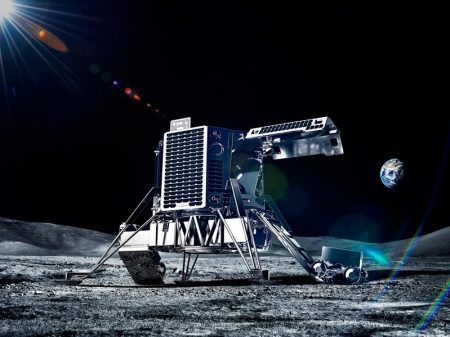May 15, 2018 – A survivor of both the 2011 earthquake that struck Japan, and the demise of the Google Lunar XPrize with no declared winner, is a flight-ready technology designed to build a permanent lunar settlement. The company called ispace has just received $90 million US in initial funding. That’s more by $30 million than the amount SpaceX received on its initial offering.
The core ispace technology is built around a lander and rover system designed during the run-up to the Lunar XPrize. The rover weighs a mere 3.75 kilograms (8.3 pounds) and is described as a bug mated to a tank. The body is carbon fiber. Its wheels look like water mills. On board, it has four cameras giving it a 360-degree view. A separate camera looks for hazards and helps to steer. The design is flexible to harbor a variety of instrumentation packages and serve multiple functions.
ispace is focused on a project it has called Moon Valley, the first planned human settlement for the Moon. To make it a reality ispace plans a number of missions beginning with a lunar surface exploration project, followed by construction of an information and transportation service platform, a mechanism to harvest water from the lunar poles, and then the final construction of a modular lunar habitat. Ten different missions are in the planning stage with the first to begin in 2019 and with completion of the lunar settlement done by the mid-2020s.
The secret sauce at ispace, states the company, is its ability to develop cheap, small, lightweight landers and rovers. The rover will be one of the smallest ever to roam an off-Earth surface, even smaller than Sojourner, the first Martian rover built by the Jet Propulsion Laboratory in Pasadena. The rover will be designed to communicate with a fleet of other rovers to coordinate work and exploration. ispace intends to create a variety of these rovers with some capable of traversing very difficult terrain carrying tools on board including drills, and a variety of robotic arms.
To make Moon Valley happen ispace intends to follow these steps:
- initial missions will acquire environmental information about the lunar surface and determine the best locations for a future lunar base
- robots will build a transportation and communication hub as a priority task
- they will subsequently then begin extracting lunar resources needed for human habitats
- and finally, they will develop human life support systems capable of sustaining a colony
The transportation and telecommunications hub will be home base for a growing community of robot landers and rovers with new generations of these autonomous creations more capable than the last both in job function and duration of mission. The end result, a lunar base built for future human colonists, in place by the mid-2020s and done relatively on the cheap.









